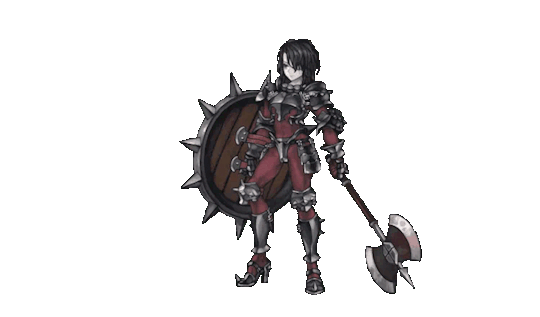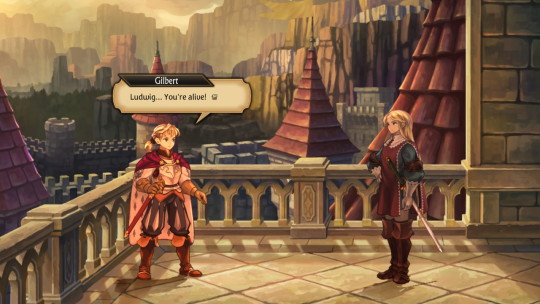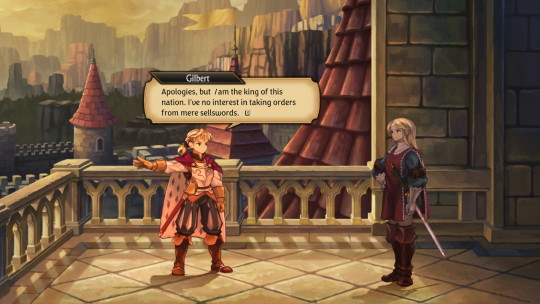#virginia/berengaria
Text

*me, looking around for Unicorn Overlord yuri like the John Travolta meme*
Fine i'll do it myself
#unicorn overlord#sharon/ochlys#virginia/berengaria#queen ilena/alcina#ochlys is like i may be an angel but that thiccness tho#if you ask virginia and ren who tops they each say its them#the truth is it's leah#oh alain haha#the answer is yes#ilena sweating over the buttons marked 'stop the incoming rebellion while its small' and 'keep banging my hot court sorceress'
88 notes
·
View notes
Text




Ren, Beren, Berengaria,
(and virginia)
23 notes
·
View notes
Text


Yelling into the Unicorn Overlord void here but does anyone else ship Virginia and Berengaria 😭
8 notes
·
View notes
Text
i think its funny that when, upon Gloucester being the first character I drew post-release, I was like "I had so many other characters I was sure i'd draw first. I wonder why I went straight to THIS guy. I mean sure i like his outfit and his character. and everything about him that i've seen so far. but" & then i realized he'd become my favorite in the game like 5 days later. the gloucester sneakup.
#unicorn overlord#i thought i would've at least drawn ithilion at least 4 more times by now#however i'd just now gotten to drawing berengaria & virginia the other day so its a slow process
7 notes
·
View notes
Text
I need more of my fire emblem pals to play unicorn overlord I love these fruity little bitches
#this is mainly about the elves and drakengard(ians?)#but I haven’t made it all the way through bastorias yet#unicorn overlord#this is applicable to so many of the characters but especially these#yahna#chloe unicorn overlord#ridiel unicorn overlord#rosalinde unicorn overlord#eltolinde unicorn overlord#liza unicorn overlord#berengaria unicorn overlord#Virginia unicorn overlord
8 notes
·
View notes
Text
Married man friendzones his thirsty friend while the strong girls tsundere eachother
youtube
1 note
·
View note
Text




Unicorn Overlord | Sprite Animations
(From Top to Bottom) Gilbert, Virginia, Berengaria, Aramis
#unicorn overlord#vanillaware#gif warning#more info yay!!#also i love aramis' animation#unilord sprites
221 notes
·
View notes
Text
Finished Unicorn Overlord. Pretty fun overall, though the story is nothing to write home about.







Ended up using a decent variety of squads to clear, though 90% of the legwork was done by Alain's main well rounded team. They cleared basically everything in the game without much issue other than a handful of the post-endgame colosseum fights that needed a bit of tweaking.
Berengaria and Virginia's squad was my next biggest heavy hitter, followed by the Mobility Squads with the full set of knights and the full set of fliers.
The berserker frontline squad started off okay but really fell off the map in the lategame when Berserkers really just don't cut it anymore. Travis's Truestrike Team was mostly a utility pick for dodge tanking and ALSO negating enemy dodge tanks, but didn't end up doing that much clearing long term.
I've also got a couple random support teams tacked on the end there that mostly sat in towers or picked up items.
I feel like I did pretty well without assembling any true power combo teams, and the games got a great team building element to it.
8 notes
·
View notes
Text
Unicorn Overlord Act 2/Drakenhold: Siblings save the day
Honestly, what a step up from the beginning of the game.
Characters you've recruited in Cornia are put back in the spotlight which does them and the setting wonders! The tension between Drakenhold and Cornia suggests a world where things aren't as cut and dry as Act 1 suggested, and while ultimately any past animosity is erased in the face of the one big generic evil faction, remnants of the conflict are hinted at, enough for the imagination to envision a more layered intrigue.
The final stage in castle Soldraga having story and gameplay interact in such a neat way made it such a great conclusion! I knew I had to meet Gilbert before the assault, but seeing as I didn't find the route, I just decided to head in anyway. The mission starts with a dialogue that very clearly tells you that, maybe, you should have acted differently so I re-loaded and found my way to him eventually. Going with Gilbert's plan will have him find out his brother is still alive, and join your army. My bf got the other outcome and I can appreciate that the game offer a variant here, but I'm happier with the one I had.
The act ends by reuniting two pairs of siblings. These two scenes happening one after the other really underline the similarities between Travis/Berengaria and Gilbert/Ludwig (The resenting younger sibling abandoned by their elder whom they deeply respected) and their differences (one share a heartfelt scene while the othrs remain a little distant). I have only unlocked the first rapport conversations but I'm SO glad that they have cross-sibling-pair interactions.
The HIGHLIGHT of Drakenhold is that it gives you 4 (and a half?) pairs of siblings with compelling dynamics:
Magellan and Liza
Hilda and Primm
Berengaria and Travis
Aramis (/Ludwig) and Gilbert
(Virginia and Alain (Admittedly they're cousins but they openly compare their relationship to that of siblings so I'm counting them))
The difficulty of expert mode remains a little disappointing but I want to give a special shoutout to the quest "Two armies as one" in Früth Harbor which had me go game over 3 times because the guest unit on the other side of the map can't take more than 3 hits and desperately needed a sped-up out-of-stamina Hilda to tank every enemy on their behalf.
6 notes
·
View notes
Text
rly love the party comp in uo. current units (in drakengard rn) and my unofficial names for them:
“they cant kill alain if theyre dead”: alain (front row, leader), aubin, berenice, yahna (back row)
firebomb: hodrick, melisandre (front row), chloe (leader), auch (the firebomb)
the boys: travis (front row, leader) lex, rolf, jeremy
“dad can you come pick me up”: josef (front row, leader, the dad in question), clive, mordon, leah (back row)
[unnamed]: adel, colm, ochlys (front row), sharon (back row, leader) (this is my healer unit)
LETS GO LESBIANS: fran (front row, leader), mariam, kitra, magellan (back row)
“get fucked”: renault (leader), berengaria (front row), virginia, aramis (back row)
#renault’s team has never been beaten. btw#the boys are THE MOST VERSATILE GROUP I HAVE. to me they have a groupchat that lex messages that travis mutes and rolf leaves on read#erm. can you tell i like sellswords and swordfighters the most#im thinking of revamping sharon’s group to have more personality skdbskbsjd#also putting magellan with the knights of the rose is so funny. theyre all dating but needed more oomph in battle.#t#uo#honestly most of the ppl who arent on a time i either dont vibe with or they have no use#i just have no use for all those clerics….#anyways! on to catch up on some rapport convos :-)
3 notes
·
View notes
Text
So after messing this up in the last playthrough, I got to recruit Gilbert in Drakenhold this time.
The Drakenhold storyline comes with some interesting sibling dynamics (Travis+Berengaria, Hilda+Primm, Gilbert+Aramis) and I especially love the juxtaposition of the first and last pairs' reunions right after one another.
Travis and Berengaria do not start off on the best terms, they clearly have some past matters to chew on, but when they finally make up it's such a sweet and heartfelt scene.


That little hug after them talking things through. Way to make me feel things about characters I didn't really care for up to that point.
Coincidentally, one of the other siblings shows up in the scene and boy. The vibes are rancid, may I say.

Go off, passive agressive king. On that note, I felt like this one sounded even more bitter in the German localization.

"It's bitter to be abandoned. Especially by a loved person."
Anyway, he does have a good reason to feel this way. Six years ago the kingdom got invaded, his father died in battle and in the same breath his brother, the crown prince, "went missing" without a word (aka, decided to go "yea no screw those royal duties I'm out of here bye").
How old is Gilbert exactly? With his height and some characters calling him "kid" (which I believe isn't literal, but still), is he even 18? Like, how old was he six years ago when he was left alone in the middle of the kingdom's invasion?
Anyway the two long-lost siblings get to reunite after Soldraga is liberated, and it's.... stiff. Expectedly so.

Yup, sure is. On that note, it makes absolutely no difference in meaning but I still find it interesting the German version opts for the wording "I thought you were dead".


"Where have you been all these years?"
Anyway Aramis gives him the brief overview; how the army fell in battle, their father died, and out of shame of facing the kingdom's people after his failure he decided to take on a new name and go undercover. Gilbert does try to tell him their father's death isn't his fault, but that discussion goes kinda nowhere.



I don't know if it's just a language thing but despite meaning the exact same thing I always feel like the German translation comes off as ever so slightly more snarky. Maybe that's a me thing though.
Aramis pins his return on being coerced by Alain (and Virginia might I add), so... very clearly not out of his own good will to clear things up with his little brother.
I also can't help but notice that for a lot of their conversation Aramis either keeps his eyes averted from Gilbert, or his back turned to him.
It's not all entirely unloving though. They do try.


I'm fairly certain it's implied in the German translation as well, but still I find it interesting there is no "I'm proud of you" in there. "You're doing well. Father surely is proud of you."
Anyway, one exchange about who of the two is worthy of ruling the kingdom later Aramis decides it's time to leave again. Gilbert then announces he will join the liberation army to fight at his side. Despite his big brother's objections.


Finally a little bit of lighthearted bickering at the end of their conversation.
Still it's all very... well, Lou and I called it "constipated". The entire conversation feels very impersonal. It's all very much about the kingdom, about rulership. After six years apart there is no "I'm glad to see you", no "I missed you". It makes sense given the situation. It makes sense for their characters. I like that it was written this way. And I like it as a contrast to the very sweet sibling reunion that happens right before.


5 notes
·
View notes
Text
Thinking more abt the EO/UO crossover isekai AU... thing.
If i were to stick with an eo3 setting, and try to fill in a team of 5, I could easily see Primm as a Monk. Main healing class and all (until Primm uses monk weapon glitch & unlocks Yagrush breakfire fist).
And because of favoritism I'd probably draw Berengaria & Virginia in too. Also all these characters have lived in Drakenhold. Virginia could be a Hoplite, OR sword gladiator honestly. But likely Hoplite.
Berengaria's tougher. Her big deal is being a fucking monster-- I mean capitalizing on ailments and having some draining abilities. Also debuffing and just dealing nutty damage in general. She can do it all. To me this translates closest to Arbalist or something. Just massive damage & the ability to capitalize on ailments. Actually maybe ninja too. Or just ninja subclass.
Buccaneer/Gladiator/Hoplite/Monk/Arbalist sounds like a nice and balanced formation, but that'd just be 5 frontliners if i actually built that team.
9 notes
·
View notes
Text
Round three bracket!
Yahna vs Magellan
Melisandre vs Yunifi
Scarlett vs Ridiel
Ochlys vs Berenice
Primm vs Sharon
Lhinalagos vs Rolf
Tatiana vs Mandrin
Gloucester vs Ithilion
Chloe vs Josef
Kitra vs Travis
Virginia vs Railanor
Aubin vs Aramis
Berengaria vs Lex
Ilenia vs Amalia
Auch vs Miriam
Hilda vs Gilbert
1 note
·
View note
Text
Events 5.12
254 – Pope Stephen I takes office, and takes a stand against Novatianism.
907 – Zhu Wen forces Emperor Ai into abdicating, ending the Tang dynasty after nearly three hundred years of rule.
1191 – Richard I of England marries Berengaria of Navarre in Cyprus; she is crowned Queen consort of England the same day.
1328 – Antipope Nicholas V, a claimant to the papacy, is consecrated in Rome by the Bishop of Venice.
1364 – Jagiellonian University, the oldest university in Poland, is founded in Kraków.
1510 – The Prince of Anhua rebellion begins when Zhu Zhifan kills all the officials invited to a banquet and declares his intent on ousting the powerful Ming dynasty eunuch Liu Jin during the reign of the Zhengde Emperor.
1551 – National University of San Marcos, the oldest university in the Americas, is founded in Lima, Peru.
1588 – French Wars of Religion: Henry III of France flees Paris after Henry I, Duke of Guise, enters the city and a spontaneous uprising occurs.
1593 – London playwright Thomas Kyd is arrested and tortured by the Privy Council for libel.
1743 – Maria Theresa of Austria is crowned Queen of Bohemia after defeating her rival, Charles VII, Holy Roman Emperor.
1778 – Heinrich XI, count of the Principality of Reuss-Greiz, is elevated to Prince by Joseph II, Holy Roman Emperor.
1780 – American Revolutionary War: In the largest defeat of the Continental Army, Charleston, South Carolina is taken by British forces.
1797 – War of the First Coalition: Napoleon I of France conquers Venice.
1821 – The first major battle of the Greek War of Independence against the Turks is fought in Valtetsi.
1846 – The Donner Party of pioneers departs Independence, Missouri for California, on what will become a year-long journey of hardship and cannibalism.
1862 – American Civil War: U.S. federal troops occupy Baton Rouge, Louisiana.
1863 – American Civil War: Battle of Raymond: Two divisions of James B. McPherson's XVII Corps turn the left wing of Confederate General John C. Pemberton's defensive line on Fourteen Mile Creek, opening up the interior of Mississippi to the Union Army during the Vicksburg Campaign.
1864 – American Civil War: The Battle of Spotsylvania Court House: Union troops assault a Confederate salient known as the "Mule Shoe", with the fiercest fighting of the war, much of it hand-to-hand combat, occurring at "the Bloody Angle" on the northwest.
1865 – American Civil War: The Battle of Palmito Ranch: The first day of the last major land action to take place during the Civil War, resulting in a Confederate victory.
1870 – The Manitoba Act is given the Royal Assent, paving the way for Manitoba to become a province of Canada on July 15.
1881 – In North Africa, Tunisia becomes a French protectorate.
1885 – North-West Rebellion: The four-day Battle of Batoche, pitting rebel Métis against the Canadian government, comes to an end with a decisive rebel defeat.
1888 – In Southeast Asia, the North Borneo Chartered Company's territories become the British protectorate of North Borneo.
1926 – The Italian-built airship Norge becomes the first vessel to fly over the North Pole.
1932 – Ten weeks after his abduction, Charles Jr., the infant son of Charles Lindbergh, is found dead near Hopewell, New Jersey, just a few miles from the Lindberghs' home.
1933 – The Agricultural Adjustment Act, which restricts agricultural production through government purchase of livestock for slaughter and paying subsidies to farmers when they remove land from planting, is signed into law by President Franklin D. Roosevelt.
1937 – The Duke and Duchess of York are crowned as King George VI and Queen Elizabeth of the United Kingdom of Great Britain and Northern Ireland in Westminster Abbey.
1941 – Konrad Zuse presents the Z3, the world's first working programmable, fully automatic computer, in Berlin.
1942 – World War II: Second Battle of Kharkov: In eastern Ukraine, Red Army forces under Marshal Semyon Timoshenko launch a major offensive from the Izium bridgehead, only to be encircled and destroyed by the troops of Army Group South two weeks later.
1942 – World War II: The U.S. tanker SS Virginia is torpedoed in the mouth of the Mississippi River by the German submarine U-507.
1948 – Wilhelmina, Queen regnant of the Kingdom of the Netherlands, cedes the throne.
1949 – Cold War: The Soviet Union lifts its blockade of Berlin.
1965 – The Soviet spacecraft Luna 5 crashes on the Moon.
1968 – Vietnam War: North Vietnamese and Viet Cong forces attack Australian troops defending Fire Support Base Coral.
1978 – In Zaire, rebels occupy the city of Kolwezi, the mining center of the province of Shaba (now known as Katanga); the local government asks the US, France and Belgium to restore order.
1982 – During a procession outside the shrine of the Virgin Mary in Fátima, Portugal, security guards overpower Juan María Fernández y Krohn before he can attack Pope John Paul II with a bayonet.
1989 – The San Bernardino train disaster kills four people, only to be followed a week later by an underground gasoline pipeline explosion, which kills two more people.
1998 – Four students are shot at Trisakti University, leading to widespread riots and the fall of Suharto.
2002 – Former US President Jimmy Carter arrives in Cuba for a five-day visit with Fidel Castro, becoming the first President of the United States, in or out of office, to visit the island since Castro's 1959 revolution.
2003 – The Riyadh compound bombings, carried out by al-Qaeda, kill 26 people.
2006 – Mass unrest by the Primeiro Comando da Capital begins in São Paulo (Brazil), leaving at least 150 dead.
2006 – Iranian Azeris interpret a cartoon published in an Iranian magazine as insulting, resulting in massive riots throughout the country.
2008 – An earthquake (measuring around 8.0 magnitude) occurs in Sichuan, China, killing over 69,000 people.
2008 – U.S. Immigration and Customs Enforcement conducts the largest-ever raid of a workplace in Postville, Iowa, arresting nearly 400 immigrants for identity theft and document fraud.
2010 – Afriqiyah Airways Flight 771 crashes on final approach to Tripoli International Airport in Tripoli, Libya, killing 103 out of the 104 people on board.
2015 – A train derailment in Philadelphia kills eight people and injures more than 200.
2015 – Massive Nepal earthquake kills 218 people and injures more than 3500.
2017 – The WannaCry ransomware attack impacts over 400,000 computers worldwide, targeting computers of the United Kingdom's National Health Services and Telefónica computers.
2018 – Paris knife attack: A man was fatally shot by police in Paris after killing one and injuring several others.
0 notes
Text
A poster for Youssef Chahine’s 1963 action film ‘Saladin’ (original title: ‘El Naser Salah el Dine’) starring Ahmed Mazhar. (Photo by Movie Poster Image Art/Getty Images)
A discussion of Youssef Chahine’s Saladin which offers some context on the cinematic representation of Saladin in relation to Richard the Lion Heart, some historical information in its relation to Egyptian President Gamal Abdel Nasser’s efforts to maintain a United Arab Republic, and Chahine’s attempts to narrate those aspirations through the story of Saladin. We admire the film’s use of the CinemaScope frame, its staging in depth, its use of colour, and editing; and bemoan the way some of the action is directed. A huge popular success in its day. An Arab answer to the epics then so popular in Hollywood, not least in offering an Arab point-of-view on the Crusades; and a cultural mainstay through its regular rotation on television: this was also reputedly Nasser’s favourite film.
As time goes on, Richard and I are becoming better informed, partly just through watching more of Chahine’s work, but also through the arrival of different types of information that we will post on here as and when we get it. This week’s arrivals are a wonderful book on Chanine’s work by Malek Khouri, The Arab National Project in Youssef Chahine’s Cinema (Cairo: The American University in Cairo Press, 2010).
According to Khouri, ‘When Chahine embarked on the making of Saladin (1963) the atmosphere in Egypt and the Arab world was still experienced (sic) the negative effects of the failure of the attempt to create a United Arabl Republic (AUR). The disbanding of the Union in the aftermath of a secessionist military coup d’état in Syria in 1961) was a major blow to the Nasser revolution and its pan-Arab project. Whilt the move in Damascus exposed frustrations with repressive Egyptian administrative and political praactices in Syria with the miliatry and economic elite, the secession, nevertheless, did not reflect the deep-rooted pro-Arab unity sentiments in Syria. Jst two years later a counter coup took place in Damascus, restoring pro-union supporters to power. TheUnited Arab Republic, however, did not re-emerge after the change of leadership in Damascus, and Egypt alone remained in the union until its name was changed in 1971 after the death of Nasser’ (p.42).
Khouri sees Chahine’s film as ‘the most pivotal of the 1960’s) and one ‘clearly informed by this critical moment in contemporary Arab history with all its preoccupations, hopes, and anxieties over the prospect of national unity’ (p.44).
According to Chahine himself, ‘in Saladin, I was not hesitant in telling Christians that they were wrong in coming over to occupy our land. I, myself a Christian, have lived in the heart of Muslim culture where 90 per cent of the people whom I loved were Muslims…From the time of Andalusia to (today’s) Alexandria, the idea of diversity within a predominantly Muslim culture has been much more integrated than it has ever been within mostly Christina societies. There are not just words…This is exactly how I feel (cited in Khouri, p.45). The podcast can be listened to below:
https://soundcloud.com/user-766042506/the-youssef-chahine-podcast-no-4-jose-and-richard-on-saladin-egypt-1963
I have included some clips we refer to in the podcast. Here the murder of the pilgrims which Khouri praises for its use of colour and for its focus, ‘on the symbolic rathe than on literal interpretation and presentation).
The film has marvellous cutting and a very inventive use of CinemaScope. Khouri notes how ‘Theatrical and print advertisements touted its Cinemascope technology (a first in Arab Cinema), its star power (an ensemble featuring many popular Egyptian actors), and its massive number of extras.
You can further admire the use of widescreen and staging in depth in the clip below, though I posted it mainly for its unusual portrait of female warriors (though admittedly Virginia is also the villain of the piece)
The film has brilliant use of a dramatic, theatrical, split screen:
The film provides further proof of the sensuality evident in Chahine, such as in the clip below where a dancing girl is paid to gather information.
and the homoeroticism is also evident:
According to Khouri, ‘The film positions Saladin as a man of moral integrity, in radical contrast to the way he has traditionally been imagined in western cinema’ (p.45). Richard, however, argues that this is not quite the case, pointing to De Mille’s The Crusades (1935) and providing the original New York Times review of the film which argues that, ‘A gallant victor, Saladin abandoned his plan to add Berengaria to his harem, sent her back to Richard and threw the Holy City open to Moslems and Christians alike.It is Saladin, in fact, who emerges as the real hero of the photoplay.’ This view is ratified by a recent review of the same film in The Guardian.
Richard also pointed me to a youtube clip from the Doctor Who version – Saladin played in blackface but sympathetic in opposition to Richard the Lionheart (we discuss Saladin’s ‘whitefacing’ of westerners in the podcast); and a trailer for the 1954 version of King Richard and the Crusaders, which looks hilarious. But again it seems to be a sympathetic portrayal of Saladin and the villains are Richard’s underlings.
The other arrival this week that enhanced my understanding of Saladin was Twflik Hakem’s book of interviews with Chahine, Youseff Chahine, Le révolutionnaire tranquille (Paris: Capricci, 2018). There, Hakem claims Chaine convinced President Nasser that Saladin could be no other than himself and charmed him into putting his army and his administration at Chahine’s disposal so he could make the film (Tu as pu faire croire au président Nasser que Saladin ça ne puvait être autre que lui et il a mis à ta dispoition son armée et son administration pour que tupuisses mettre en chantier une superproduction et réaliser ton rêve hollywoodien’ (loc 256 of 1750 on Kindle).
We learn from Hakem that Nasser adored the film and Chahine tells him, ‘yes, he wanted a copy on hand (by his bed). Whenever a visitor came to see him, he had the film projected. He would usually fall asleep because he’d seen it hundreds of times but would wake up at the end and say ‘good he?’ All of that is true but the first truth is that the film is not at all to the glory of Nasser, it’s nreally not. (Oui, il avait une copie du film sous le lit. Chaque visiteur qui venait le voir, il lui faisait projeter dans sa salle de projection. Lui dormait, parce qu’l avait vu cent foies et il se révellait juste avant la fin pour dire au visiteur: v”Alors? C’est bien hein? Tout cela est vrai mais la véritér première est que le film n’est pas du tout à la gloire de Nasser, mais vraiment pas.’
The Ritrovato Catalogue’s entry on the film is below:
According to Khouri, Saladin was extremely popular, ‘in a contemporary assessment of the overwhelming popular uccess of the film, a local newspaper described how Saladin played to full houses in almost every large theatre in Cairo and Alexandria for weeks in order to allow pople to watch it along with their entire families: ‘This is a film which makes us all feel proud…and it is a miracle indeed that it was made in the first place (p.49)! The film continues to resonate across the Arab world. Over twenty-six years after the film was released, according to Khouri, one local critic wrote, ‘I asked a friend of mine, a woodworker, did you see the film Saladin last night and he said, If this film was shown a hundred times in a hundred days I would still sit and watch it.
In the UK however, Time Out, wrote a very dismissive three-line review.
José Arroyo
The Youssef Chahine Podcast with José Arroyo and Richard Layne: No. 4 Saladin (Youssef Chahine, Egypt, 1963) A discussion of Youssef Chahine's Saladin which offers some context on the cinematic representation of Saladin in relation to Richard the Lion Heart, some historical information in its relation to Egyptian President Gamal Abdel Nasser's efforts to maintain a United Arab Republic, and Chahine's attempts to narrate those aspirations through the story of Saladin.
#Cinemascope#Doctor Who#Epics#King Richard and the Crusaders#Le révolutionnaire tranquille#Malek Khouri#Nasser#Richard the Lionheart#Ritrovato Catalogue Bologna#Runaway Productions#Saladin#Tewkif Haken#The Arab National Project in Youssef Chahine&039;s Cinema#The Crusades#The Youssef Chahine Podcast#Youssef Chahine
1 note
·
View note